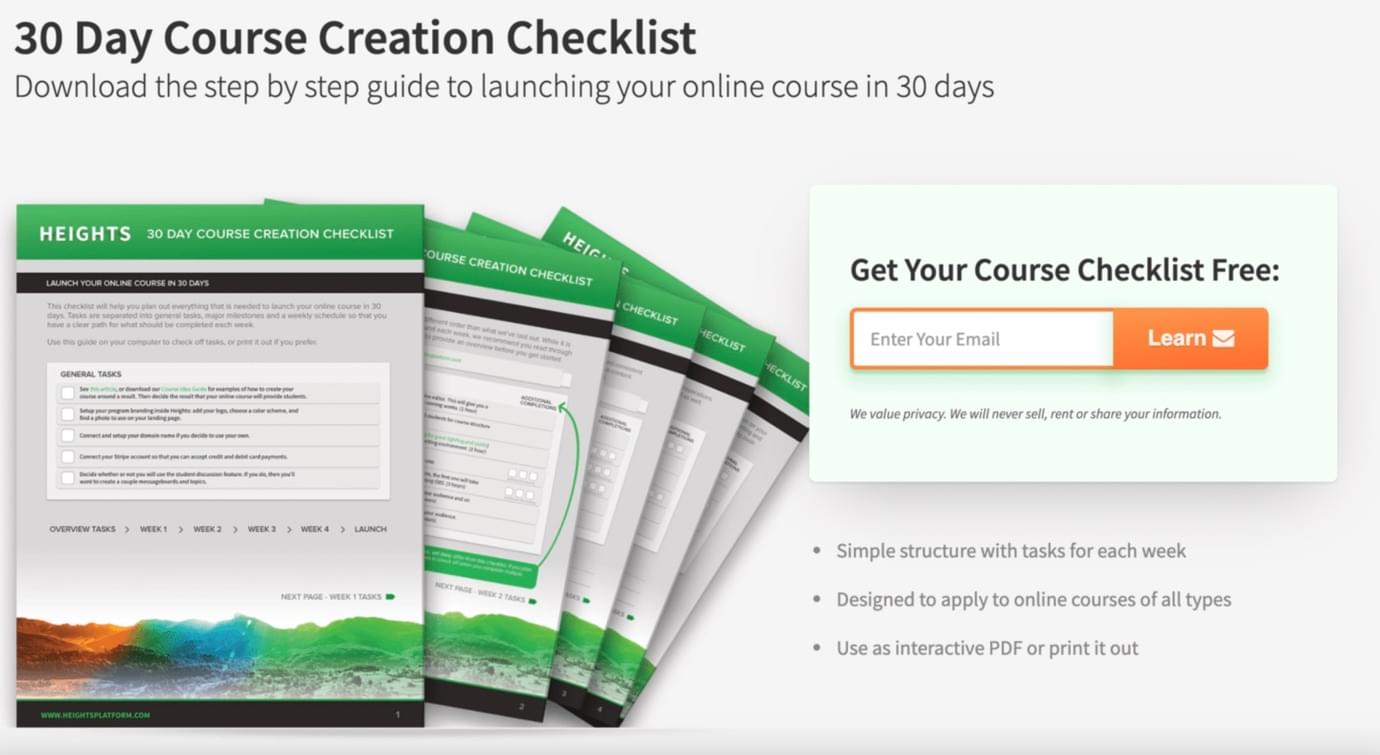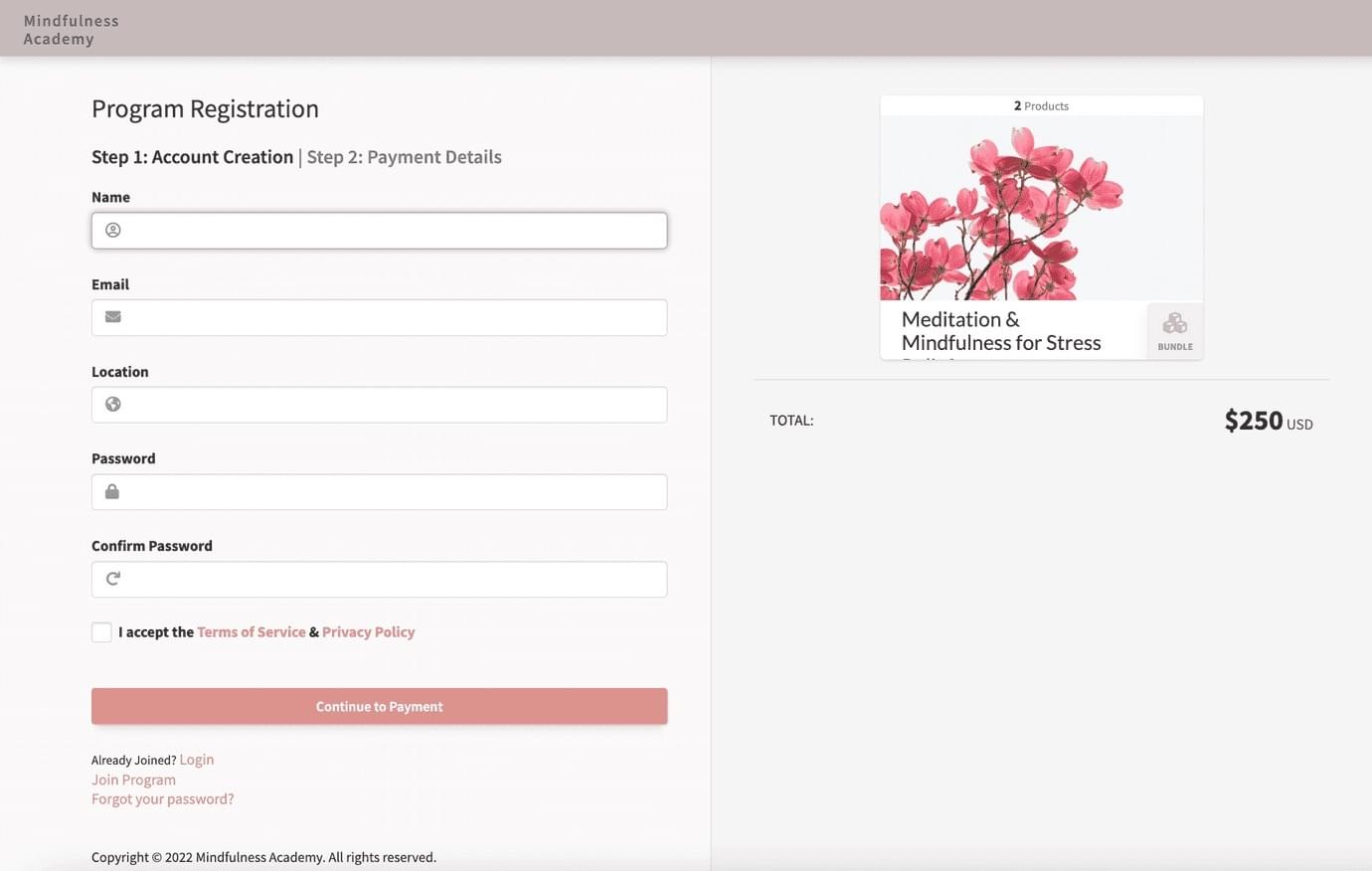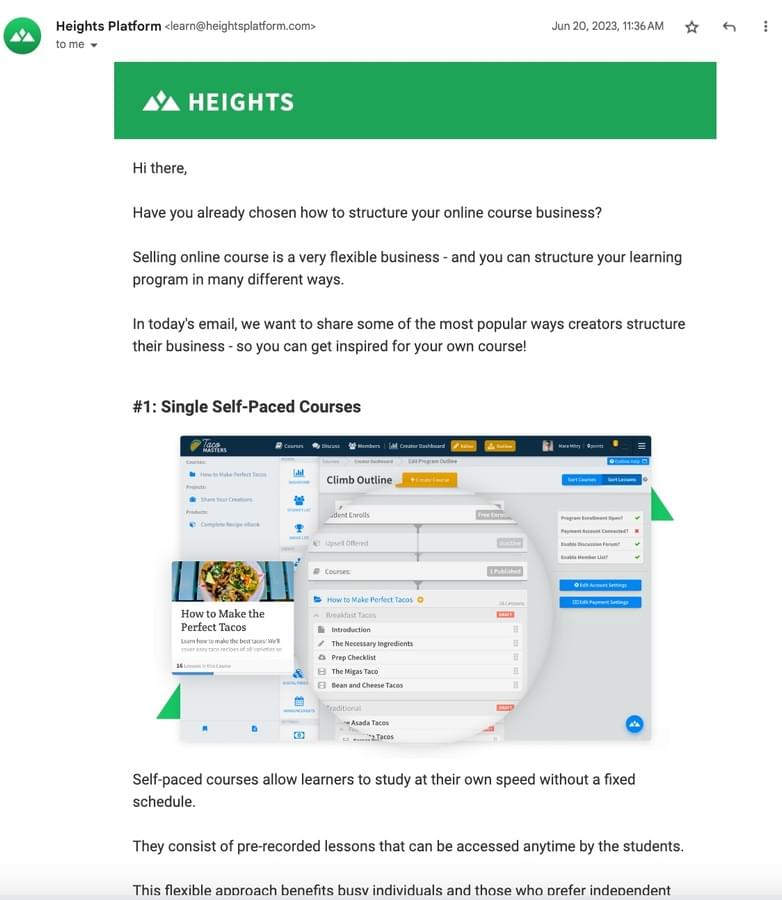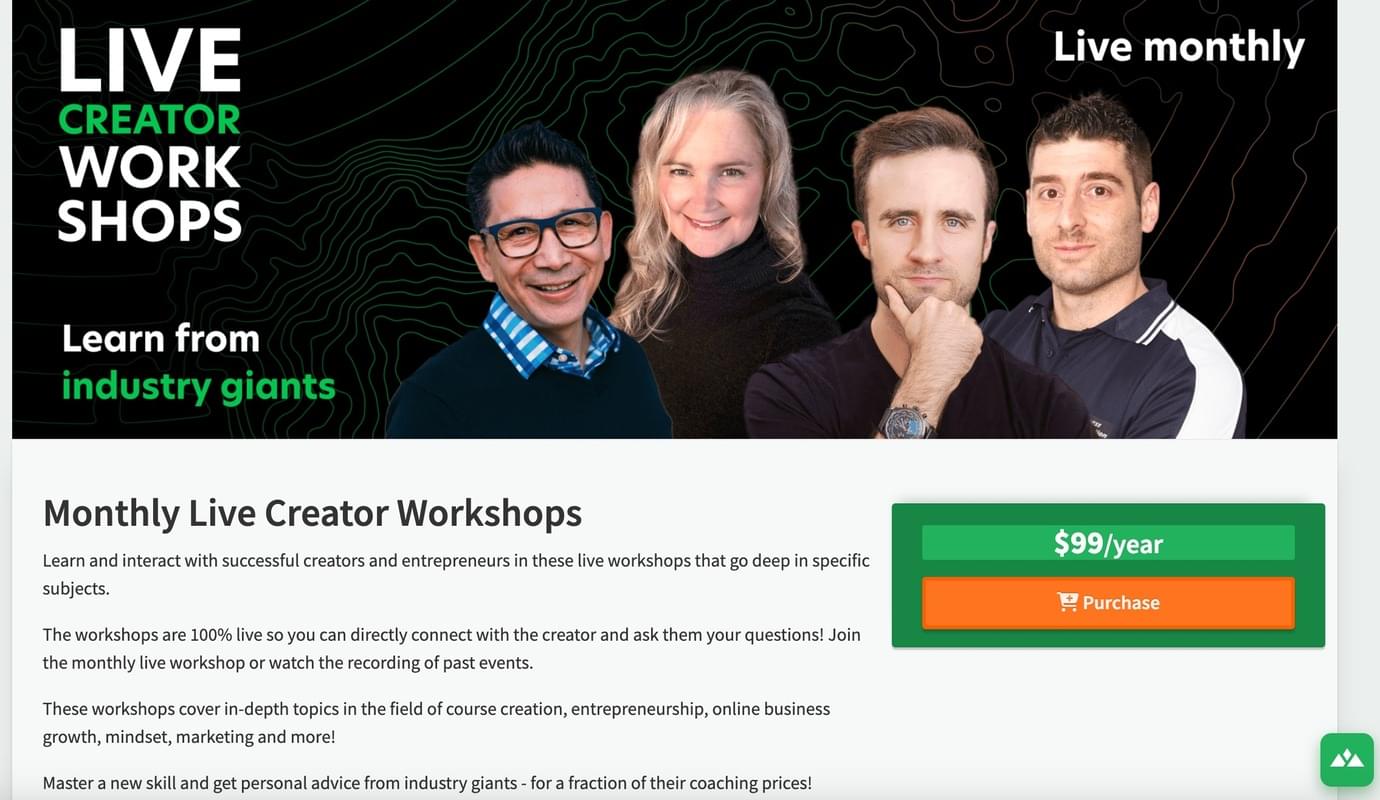How to Build an Email List From Scratch
13 minute readEmail marketing holds immense potential to boost your online business conversion rates, with an average ROI of 4,200%.
This strategy is a powerful way to promote your digital products and drive sales. However, to make email marketing work, you need a list of contacts to send your messages to.
In today's article, we will share the most effective strategies for growing your email list from scratch, making it easier to collect potential students' contact information for your online course.
If you want to learn more about email marketing, check out this article from our blog: Guide to Email Marketing to Promote and Sell an Online Course
The Power of an Email List
An email list is a valuable means of direct communication with your audience, customers and leads.
It includes the information and email addresses of subscribers interested in receiving updates, newsletters, or marketing messages from you.
Building your own email list has so many benefits!
Email marketing is a great way to personalize communication with your audience, build relationships, boost brand awareness, and drive sales as a result.
Once you collect a sizeable email list, you can start sending emails to your subscribers, informing them about new updates, announcements, or marketing offers.
The email addresses in your list should be obtained from individuals who have willingly provided their contact information, often by signing up through a website, subscribing to a newsletter, making a purchase, or participating in events.
Because of the power of email marketing and the low costs associated with building an email list and promoting a business through emails, this strategy is widely used by business content creators to communicate with their audience or customer base.
The best thing about email marketing is that it allows creators to reach a targeted group of people directly in their email inboxes, offering a more personalized approach, sharing information and building relationships.
Your email list is not just a number: maintaining a high-quality email list is important to ensure that the recipients are actually interested in the content being sent and that the emails are not marked as spam.
This involves practices such as obtaining consent for sending emails (often through opt-in mechanisms), providing easy ways for recipients to unsubscribe, and adhering to regulations such as the General Data Protection Regulation (GDPR) for handling personal data.
You can use email marketing software like ActiveCampaign and Convertkit to manage and automate email campaigns, track metrics such as open rates and click-through rates, and segment the email list based on various criteria to deliver more relevant content to different groups of recipients.
So email marketing campaigns sounds great. But in order to start promoting your business through email marketing, you need to have an email list first.
If you have zero contacts in your list, how do you build an email list from scratch?
This is what we will cover in today's article, so keep reading below to learn how to build an email list, and collect email subscribers.
How to Build an Email List from Zero
Here are actionable strategies to kickstart your email list growth and engage potential students for your online course:
Add a Sign-Up Form to Your Website
Adding a sign-up form to your website is a foundational step in building your email list.
This form serves as an open invitation for visitors to provide their contact information, enabling you to establish direct communication with them.
By strategically placing the form on your website's prominent pages, such as the homepage, blog posts, and landing pages, you maximize its visibility.
When visitors submit their email addresses through the sign-up form, you gain their permission to reach out to them with newsletters, updates, and promotional content related to your business.
To do this, you'll need a functioning website and email marketing software like ActiveCampaign and Convertkit.
These platforms offer user-friendly tools to create and embed forms seamlessly, allowing you to not only capture email addresses but also personalize your interactions and nurture your leads effectively.

Remember, the design and wording of your sign-up form are crucial. Clearly communicate the benefits of subscribing and what subscribers can expect to receive. Additionally, consider offering a lead magnet—a valuable free resource—in exchange for signing up (more about this later).
This not only entices visitors to provide their information but also starts building a sense of trust and value from the beginning of your relationship with potential students.
Offer an Incentive for Subscribers
Offering an incentive is a compelling way to entice potential customers to join your email list.
An incentive is something valuable that you provide in exchange for their email addresses.
The key to a successful incentive lies in its relevance and value to your target audience. By offering something that addresses their needs, interests, or pain points, you increase the likelihood of them willingly sharing their contact information.
For example, if you're selling an online course on healthy cooking, your incentive could be a free downloadable recipe book with nutritious and easy-to-follow recipes, or a 10% discount on your course.
This not only caters to the interests of your potential customers but also establishes you as a valuable resource in your niche.
Remember, the incentive serves as the first impression of the value you bring to your audience. It's not just about collecting email addresses; it's about building trust and showcasing the quality of content you provide.
This way, when recipients receive your emails in the future, they'll have a positive expectation of the value you consistently deliver.
Create Lead Magnets
Creating a lead magnet is a highly effective method for building your email list from scratch.
A lead magnet is a valuable piece of digital content that you offer to your audience for free in exchange for their email addresses.
Same with any other type of incentive, the content of the lead magnet should resonate with your target audience and provide them with immediate value or a solution to a problem they're facing.
Lead magnets can take various forms, such as informative eBooks, practical worksheets, exclusive video tutorials, or even access to a mini-course.

The key is to align your lead magnet with the interests and needs of your potential students. By offering something genuinely valuable, you establish trust and encourage them to willingly share their contact information.
When designing your lead magnet, focus on delivering quality rather than quantity.
Craft content that showcases your expertise, offers actionable insights, and leaves your audience wanting more.
Learn all about creating a lead magnet to grow your email list: How to Create a Great Lead Magnet That Converts to Promote Your Online Course
Start a Waitlist for Your Next Product
Starting a waitlist is a strategic approach that can significantly boost your email list and engage potential customers effectively.
Especially if you are selling info products such as online courses, this strategy has many benefits.
By creating a waitlist for your upcoming product launch, you're essentially inviting individuals who are genuinely interested in your product to join a pre-launch notification group.
This holds great value for several reasons.
Firstly, it allows you to capture the email addresses of individuals who are highly motivated to purchase your product when it becomes available.
These people, often referred to as "hot leads," have already expressed a strong interest in your product or service and are eagerly awaiting its release.
Setting up a waitlist requires minimal effort in terms of resources and lead magnets, making it an efficient way to collect valuable leads.
Plus, a waitlist enables you to nurture your potential customers even before your product is officially launched.
You can keep them engaged by providing sneak peeks, exclusive insights, and early access information, gradually building a sense of anticipation.
Additionally, the waitlist provides you with a unique opportunity to offer special offers, discounts, or bonuses exclusively to those on the list, increasing the chances of conversion once the course is live.
In the case of online courses, starting a waitlist not only enhances the quality of your leads but also sets a foundation for a successful course launch.
It fosters a sense of community and exclusivity - and, as a result - when the course is finally launched, you'll have a group of enthusiastic individuals ready to enroll, increasing your chances of early success and positive word-of-mouth marketing.
Add Pop-Up Forms to Your Site
Pop-up forms are designed to (as the name describes) pop up on your website based on specific user actions, such as entering the site, spending a set amount of time on a page, or attempting to exit the page.
Pop-up forms can effectively prompt visitors to take action by offering incentives like exclusive discounts, access to valuable resources, or a lead magnet.
However, it's crucial to strike a balance: while pop-ups can be highly effective, overusing them can lead to a poor user experience and potentially turn visitors away.
When creating pop-up forms, tailor them to align with your brand's aesthetics and messaging. Clearly communicate the benefits of subscribing and ensure that the pop-up can be easily dismissed if users aren't interested.
Additionally, consider A/B testing different pop-up designs, triggers, and incentives to find the combination that resonates best with your audience, leading to increased email sign-ups and a more engaged subscriber base.
Blogging and Guest Blogging
Utilizing blogging and guest blogging is a strategic approach to not only share valuable content with your audience but also to grow your email list.
Blogging involves creating informative and engaging articles related to your online course niche.
Within these blog posts, you can incorporate opportunities for readers to sign up for your newsletter or email updates.
Guest blogging takes this a step further by collaborating with other websites or platforms in your industry.
Writing guest posts for these platforms not only exposes your content to a new audience but also positions you as an authority in your field.
Within your guest posts, you can seamlessly integrate calls to action, inviting readers to join your email list to receive more insights and resources.
This cross-promotion can help you tap into a wider network and attract like-minded individuals interested in your online course, effectively expanding your email list.
Incorporate Two-Step Checkout
A two-step checkout can be a clever strategy to capture email addresses and potentially convert customers even if they abandon their cart.
This approach involves breaking down the typical checkout process into two distinct steps.
In the first step, before the customer completes their purchase, you request their contact details, including their email address.
This allows you to capture their information even if they decide not to proceed with the transaction. By doing so, you're building your email list with potential leads who have already shown interest in your product.

The second step of the checkout process involves finalizing the purchase. By collecting their email address early on, you have the opportunity to follow up with these potential customers through email marketing.
You can send them reminders, provide additional information, and even offer incentives to encourage them to complete their purchase.
This strategy is particularly effective when integrated into platforms like Heights Platform's built-in checkout system.
With this approach, you're not only gathering crucial contact information but also creating an avenue for future engagement and conversion, even if the initial purchase is not completed.
Check out this article from our blog to learn how to create the best checkout experience in your online course: Create the Perfect Checkout Experience to Sell More Online Courses
Collect Emails Through Social Media
You can use social media to grow your email list!
Social media platforms offer a vast audience that you can tap into to attract potential email subscribers.
Here's how you can use social media to collect email addresses:
- Promote Lead Magnets: Share your lead magnets (described before), such as free resources, downloadable guides, or exclusive content, on your social media profiles. Encourage your followers to sign up to receive these valuable resources by providing their email addresses. Clearly communicate the benefits of the lead magnet to entice users to join your email list.
- Direct Call-to-Action (CTA): You can include compelling CTAs in your social media posts, inviting users to subscribe to your newsletter or join your email list. Explain what they can expect to receive and how it will benefit them. Use eye-catching visuals and persuasive language to make your CTA stand out and drive conversions.

- Paid Advertising: If your budget is up to it, you can leverage paid ads on platforms like Facebook, Instagram, or Twitter to reach a targeted audience. This allows you to create ad campaigns that highlight your lead magnets or the value of being part of your email list. By carefully selecting your target audience based on demographics, interests, and behaviors, you can attract individuals who are genuinely interested in your offerings.
- Contests and Giveaways: Organize social media contests or giveaways that require participants to provide their email addresses as an entry requirement. Ensure that the prize or reward is relevant to your business, attracting genuinely interested participants in your products or services. This method helps you collect emails and generates excitement and engagement around your brand. We will cover more about contests and giveaways later in the article.
Optimize Your Website For SEO
Optimizing for SEO (Search Engine Optimization) is crucial to building your email list and driving traffic to your website.
SEO involves various strategies and practices aimed at improving your website's visibility on search engines like Google.
When it comes to growing your email list from scratch, SEO can play a significant role in attracting organic traffic and increasing your chances of capturing potential subscribers.
Here's how you can effectively optimize your website for SEO:
- Keyword Research: Research relevant keywords and phrases that potential subscribers might use when searching for content related to your online course or industry. These keywords should be strategically incorporated into your website's content, including blog posts, landing pages, and sign-up forms.
- Quality Content Creation: Create high-quality, informative, and engaging content (such as blog posts) that aligns with your identified keywords. This content not only provides value to your audience but also signals to search engines that your website is a reliable source of information.
- Meta Tags and Descriptions: Pay attention to meta titles and descriptions for your web pages. These are the snippets that appear in search results. Craft compelling and accurate meta descriptions that entice users to click through to your website. Including your target keywords can improve your chances of ranking higher in search results.
- User-Friendly Website: Ensure your website is user-friendly, responsive, and easy to navigate on all types of devices. A well-structured website with clear categories, headers, and internal links enhances user experience and encourages visitors to explore further, reducing bounce rates and improving SEO.
- Mobile Optimization: With a significant portion of internet users accessing websites from mobile devices, optimizing your website for mobile responsiveness is crucial. Google takes mobile-friendliness into account when ranking websites in search results.
By effectively optimizing your website for SEO, you increase the likelihood of appearing in search engine results when potential subscribers are looking for information related to your niche.
This, in turn, drives organic traffic to your site, potentially leading to more sign-ups for your email list.
Remember that SEO is an ongoing process, and staying updated with the latest best practices can help you maintain a strong online presence and continue growing your email list over time.
We explain all about SEO in this blog post: All You Need to Know About SEO to Sell Online Courses
Deliver Quality Email Content
While the primary goal of your email campaigns may be to convert subscribers into paying customers, it's equally important to provide value and create a positive experience for your subscribers.
When crafting your email content, focus on offering insights, tips, educational content, or exclusive information that resonates with your target audience's interests and pain points.

This establishes your credibility as an expert and builds trust with your subscribers over time.
By consistently delivering valuable content, you reinforce the idea that subscribing to your emails is beneficial to them, increasing the likelihood that they will remain engaged and less likely to unsubscribe.
Remember that each email is an opportunity to make a positive impression and strengthen the relationship with your audience.
Avoid being overly promotional or spammy; instead, aim to strike a balance between promotional messages and content that genuinely benefits your subscribers.
Run Contests or Giveaways
Running contests or giveaways can be an effective approach to growing your email list and engaging potential customers.
These events create a sense of excitement and interaction, prompting participants to take action – in this case, providing their email addresses to enter the giveaway.
Your contest should align with your business offerings, ensuring that participants who sign up have a genuine interest in your business and they are not just doing it to get free stuff.

By structuring the event to encourage entrants to share their contact details, you can add valuable leads to your email list.
Additionally, consider promoting the contest or giveaway through various channels – from social media to your website – to maximize its reach and impact.
A while ago, we ran our own contest, which helped us to grow our email list and promote Heights Platform. In the following article, we describe how the giveaway worked, so you can get inspired for your own: Heights Platform $6000 Giveaway: Win The Ultimate Online Course Creator Toolkit
Host Webinars or Events
Hosting live online webinars or events is a great strategy for both engaging your target audience and growing your email list.
Live webinars, in particular, offer a platform to connect with potential customers on a deeper level, showcasing your expertise and building credibility within your field.
When you organize a webinar or event, participants typically need to sign up or register, providing an excellent opportunity to collect their email addresses for future communications.
These events serve as educational experiences, allowing you to share valuable insights, tips, and information related to your products or services.
Participants are drawn to these events not only for the knowledge you provide but also for the interactive nature of webinars, where they can ask questions and engage in real-time discussions.

At Heights Platform we run workshops as part of our community of creators - Creator Climb - and every month we host these live workshops with different guests and leading authorities in various niches.
The workshops are live, so participants can ask anything they want to the speakers and receive their unique advice!
Build an Online Community
An online community is a virtual gathering space where like-minded individuals can come together to share ideas, ask questions, and engage in discussions related to a specific topic.
Using a course and community platform like Heights Platform, you can create an environment encouraging interaction and collaboration among your customers and leads.
This offers you a unique opportunity to capture email addresses as individuals join the community.
However, an online community isn't just about list-building; it's about cultivating a supportive and engaging ecosystem where participants can learn from each other, offer insights, and gain a deeper understanding of the subject matter.

As community members engage, ask questions, and seek guidance, you have the chance to connect with them more personally, creating a stronger foundation for future email marketing campaigns.
A community can have so many benefits for your business, but it is important to remember that you constantly need to interact with your members, produce new content and moderate the community.
With Heights Platform's community feature, the community is perfectly integrated with your storefront and your customers can easily access it from the other products (online courses, digital downalods, challenges) you sell.
In Heights Platform, you can easily customize the community structure and feel, by creating communication channels for different topics, grouping them into channel groups, and moderating posts within the community.
Promote Your Newsletter With Content Creation
Promoting your newsletter is a crucial aspect of growing your email list and effectively engaging with your target audience.
While crafting valuable content and offering incentives are important, it's equally vital to spread the word about your newsletter's existence.
One effective way to promote your newsletter is by seamlessly integrating it into your content creation efforts.
Whether you run a blog, podcast, YouTube channel, or social media profiles, take advantage of these platforms to inform your audience about your newsletter. This can be done by mentioning it within your content or creating dedicated posts about the benefits of subscribing.
Additionally, leverage the power of your existing email list to encourage subscribers to share your newsletter with their networks. You can add a "Refer a Friend" section in your emails, incentivizing current subscribers to forward your emails to their friends and network and help you expand your reach.
Collaborating with other content creators or businesses in your niche can also be beneficial. Consider co-hosting webinars, cross-promoting each other's newsletters, or participating in joint marketing efforts to tap into each other's audiences.
Tools like Sparkloop allow you to recommend other newsletters after someone subscribes to yours, and other newsletters can do the same with yours.
Learn more about other promotion ideas for an online business: A Complete Guide on How to Promote Your Online Course and Boost Sales
Conclusion
Growing an email list from scratch is a pivotal step in promoting your online business successfully.
Employing the strategies described in this article allows you to build a receptive audience, foster relationships, and increase your chances of driving conversions.
By implementing these techniques, you'll be well on your way to build an email list, even if you are starting from scratch!
But what about after you collect enough leads in your email list? Check out this blog post to discover the most important emails to send when marketing your business: 7 Emails You Need to Send to Promote Your Online Course
Create Your Online Course Today


